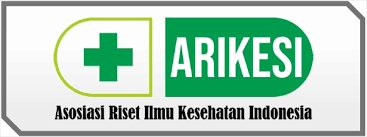Relationship of HbA1c, Hematocrit, Erythrocytes, MCV in Type 2 Diabetes at Husada Utama Hospital, Surabaya
Abstract
Introduction: Diabetes Mellitus (DM) is a prevalent endocrine disorder characterized by hyperglycemia. Hematological parameters such as Hematocrit (Hct), Erythrocyte Count (RBC), and Mean Corpuscular Volume (MCV) have been linked to the pathological mechanisms and complications of DM. This study investigates the relationship between glycemic control status (based on HbA1c results) and these hematological parameters in type 2 DM patients. Methods: This cross-sectional study included 43 type 2 DM patients from Husada Utama Hospital, Surabaya. Data, including HbA1c, Hct, RBC, and MCV values, were collected from patient medical records. Results: The Spearman Rank test results between glycemic control status (HbA1c) and hematocrit in type 2 DM patients showed p=0.013 with r=0.374, indicating a significant moderate positive correlation (r = 0.3 to 0.5, p < 0.05). The Spearman Rank test results between glycemic control status (HbA1c) and erythrocyte count showed p=0.008 with r=0.402, also indicating a significant moderate positive correlation (r = 0.3 to 0.5, p < 0.05). However, the Spearman Rank test results between glycemic control status (HbA1c) and MCV showed p=0.052 with r=-0.302, indicating a moderate negative correlation (r = -0.3 to -0.5) that is not statistically significant (p > 0.05). Conclusion: There is a notable relationship between glycemic control and hematological parameters in type 2 DM patients. Poor glycemic control is associated with significant variations in Hct, RBC, and MCV levels, highlighting the importance of monitoring these parameters in managing diabetes complications.
Keywords
References
Alamri, B.N. et al. (2019) ‘Hyperglycemia effect on red blood cells indices’, European Review for Medical and Pharmacological Sciences, 23(5). Available at: https://doi.org/10.26355/EURREV_201903_17259.
Alzahrani, B.A. et al. (2023) ‘The effect of different types of anemia on HbA1c levels in non-diabetics’, BMC Endocrine Disorders, 23(1). Available at: https://doi.org/10.1186/s12902-023-01280-y.
American Diabetes Association Professional Practice Committee (2022) ‘Classification and Diagnosis of Diabetes: Standards of Medical Care in Diabetes—2022’, Diabetes Care, 45. Available at: https://doi.org/10.2337/dc22-S002.
Arkew, M. et al. (2022) ‘Red Blood Cell Parameters and Their Correlation with Glycemic Control Among Type 2 Diabetic Adult Patients in Eastern Ethiopia: A Comparative Cross-Sectional Study’, Diabetes, Metabolic Syndrome and Obesity, 15. Available at: https://doi.org/10.2147/DMSO.S386093.
Askandar, T. et al. (2015) Buku Ajar Ilmu Penyakit Dalam. 2nd edn. Edited by Pranawa et al. Surabaya: Airlangga University Press (AUP).
Biadgo, B. et al. (2016) ‘Hematological indices and their correlation with fasting blood glucose level and anthropometric measurements in type 2 diabetes mellitus patients in Gondar, Northwest Ethiopia’, Diabetes, Metabolic Syndrome and Obesity, 9. Available at: https://doi.org/10.2147/DMSO.S97563.
Bruhn, L., Vistisen, D., Ravn Vainø, C. T., Perreault, L., & Færch, K. (2020). Physiological factors contributing to HbA1c in the normal and pre-diabetic range: a cross-sectional analysis. Endocrine, 68(2), 306–311. https://doi.org/10.1007/S12020-020-02234-3.
Carrillo-Larco, R.M. et al. (2024) ‘Mean age and body mass index at type 2 diabetes diagnosis: Pooled analysis of 56 health surveys across income groups and world regions’, Diabetic Medicine, 41(2). Available at: https://doi.org/10.1111/dme.15174.
Cho, Y.I., Mooney, M.P. and Cho, D.J. (2008) ‘Hemorheological disorders in diabetes mellitus’, Journal of Diabetes Science and Technology. Available at: https://doi.org/10.1177/193229680800200622.
Ciarambino, T. et al. (2022) ‘Influence of Gender in Diabetes Mellitus and Its Complication’, International Journal of Molecular Sciences. Available at: https://doi.org/10.3390/ijms23168850.
Dahlan, M. (2016) Besar Sampel Dalam Penelitian Kedokteran dan Kesehatan. 4th Ed. Epidemiologi Indonesia. ISBN 978-602-18408-8-7.
Destiani, S., Maksum, I.P. and Hartati, Y.W. (2023) ‘Biosensor Elektrokimia untuk Memonitor Level Hemoglobin Terglikasi (HbA1c) pada Penyakit Diabetes Melitus’, ALCHEMY Jurnal Penelitian Kimia, 19(1), p. 94. Available at:
https://doi.org/10.20961/alchemy.19.1.58439.94-107.
Di Iorio, B., & Bellizzi, V. (2001). Variations in hematocrit induced by hemodialysis. Blood Purification, 19(1), 68–69. https://doi.org/10.1159/000014481.
Ellinger, V.C.M. et al. (2006) ‘Hematological Parameters in a’, 50, pp. 114–117. Available at: https://www.scielo.br/j/abem/a/tXRjWK6N3zxXMDYvjY96TJg/?lang=en.
Farooqui, R., Afsar, N. and Afroze, I.A. (2019) ‘Role and Significance of Hematological parameters in Diabetes Mellitus’, Annals of Pathology and Laboratory Medicine, 6(3), pp. A158-162. Available at: https://doi.org/10.21276/apalm.2355.
Ferreira, D. et al. (2019) ‘Association between insulin resistance and haematological parameters: A cohort study from adolescence to adulthood’, Diabetes/Metabolism Research and Reviews, 35(8), pp. 8–9. Available at: https://doi.org/10.1002/dmrr.3194.
Green, A. et al. (2021) ‘Type 1 diabetes in 2017: global estimates of incident and prevalent cases in children and adults’, Diabetologi.a, 64(12). Available at: https://doi.org/10.1007/s00125-021-05571-8.
Gu, J., Pan, J., Fan, Y., Zhang, H., Zhang, J., & Wang, C. (2018). Prognostic impact of HbA1c variability on long-term outcomes in patients with heart failure and type 2 diabetes mellitus. Cardiovascular Diabetology, 17(1), 1–11. https://doi.org/10.1186/S12933-018-0739-3.
Hanley, A.J.G. et al. (2009) ‘Association of hematological parameters with insulin resistance and β-cell dysfunction in nondiabetic subjects’, Journal of Clinical Endocrinology and Metabolism, 94(10). Available at: https://doi.org/10.1210/jc.2009-0719.
Hashemi, S.N. et al. (2020) ‘The effects of Hyperglycemia and Hyperlipidemia on blood indices’, Journal of Advanced Pharmacy Education & Research, 10(S4), pp. 109–112. Available at: https://japer.in/storage/models/article/l5j66vIM5xF8FzwqaUSrc8b2Sgl
x7unFXtiVkCWDDzBD0LgIthAYWUdjDD4O/the-effects-of-hyperglycemia-and-hyperlipidemia-on-blood-indices.pdf.
Heinemann, L. et al. (2018) ‘Higher HbA1c Measurement Quality Standards are Needed for Follow-Up and Diagnosis: Experience and Analyses from Germany’, Hormone and Metabolic Research. Available at: https://doi.org/10.1055/a-0721-2273.
Hill, M. (2023) ‘General Principles of Endocrine Physiology. In: Molina PE. eds. Endocrine Physiology, 6e.’ Available at: https://accessmedicine.mhmedical.com/content.aspx?bookid=3307§ionid=275921626.
Hosseini, H. et al. (2014) ‘Biochezmical Interfering Factors and Blood Cells Indices’, Thrita, 3(1), pp. 3–6. Available at: https://doi.org/10.5812/thrita.15516.
Hutabarat, A.S. (2019) ‘HbA1c (Hemoglobin Glikosilasi) Pada Penderita Diabetes Melitus Tipe II Di Rumah Sakit Umum Daerah Deli Serdang Lubuk Pakam’, Skripsi [Preprint].
Irace, C. et al. (2014) ‘Blood viscosity in subjects with normoglycemia and prediabetes’, Diabetes Care, 37(2), pp. 488–492. Available at: https://doi.org/10.2337/dc13-1374.
Ismail, L., Materwala, H. and Al Kaabi, J. (2021) ‘Association of risk factors with type 2 diabetes: A systematic review’, Computational and Structural Biotechnology Journal. Available at: https://doi.org/10.1016/j.csbj.2021.03.003.
Julia L. Rogers and Valentina L. Brashers (2022) McCance & Huether’s pathophysiology : the biologic basis for disease in adults and children. 9th edn. London: Mosby.
Julia, M. et al. (2015) ‘Konsensus Nasional Pengelolaan Diabetes Melitus Tipe-2 Pada Anak Dan Remaja’. Available at: https://repository.unair.ac.id/127637/1/Buku Konsensus Nasional
Pengelolaan Diabetes Nasional Tipe 2 pada Anak dan Remaja.pdf.
Kumar, V., Abbas, A. k. and Aster, J.C. (2012) ‘Robbins Basic Pathology 9th Ed’.
MA, P. et al. (2024) Current Medical Diagnosis & Treatment 2024.
Madhusudhan, U. and Pk, J. (2019) ‘Hematocrit and its Correlation with Fasting Blood Sugar of Type II Diabetes Mellitus Patients : A Cross-Sectional Study’, pp. 8–10. Available at: https://www.researchgate.net/publication/377327299_Hematocrit_and_its_Correlation_with_Fasting_Blood_Sugar_of_Type_II_Diabetes_Mellitus_Patients_A_Cross-Sectional_Study.
Mamoun Rajab, A. and Haider, K.H. (2018) ‘Hyperglycemia and RBCs: too sweet to survive’, International Journal of Diabetes in Developing Countries, 38(4), pp. 357–365. Available at: https://doi.org/10.1007/s13410-018-0613-6.
Mandali, P.K. et al. (2023) ‘Trends in Quantification of HbA1c Using Electrochemical and Point-of-Care Analyzers’, Sensors. Available at: https://doi.org/10.3390/s23041901.
Mazzanti, L. et al. (1992) ‘Diabetes mellitus induces red blood cell plasma membrane alterations possibly affecting the aging process’, Clinical Biochemistry, 25(1). Available at: https://doi.org/10.1016/0009-9120(92)80044-H.
Milosevic, D. and Panin, V.L. (2019) ‘Relationship between hematological parameters and glycemic control in type 2 diabetes mellitus patients’, Journal of Medical Biochemistry, 38(2). Available at: https://doi.org/10.2478/jomb-2018-0021.
Nakanishi, N., Suzuki, K. and Tatara, K. (2004) ‘Haematocrit and risk of development of Type 2 diabetes mellitus in middle-aged Japanese men’, Diabetic Medicine, 21(5), pp. 476–482. Available at: https://doi.org/10.1111/j.1464-5491.2004.01152.x.
Nicoll, D., Lu, C.M. and Mcphee, S.J. (2017) ‘Lab Tests in: Guide to Diagnostic Tests’, pp. 1–6. Available at: https://accessmedicine.mhmedical.com/content.aspx?bookid=2032§ionid=152254910.
Ogurtsova, K. et al. (2022) ‘IDF diabetes Atlas: Global estimates of
undiagnosed diabetes in adults for 2021’, Diabetes Research and
Clinical Practice, 183, p. 109118. Available at:
https://doi.org/10.1016/j.diabres.2021.109118.
Olana, C. et al. (2019) ‘Abnormal hematological indices and anthropometric parameters associated with type 2 Diabetes’, International Journal of Biomedical and Advance Research, 10(November), pp. 1–8. Available at: https://doi.org/10.7439/ijbar.v10i11.5296.
Onalan, E., Gozel, N. and Donder, E. (2019) ‘Can hematological parameters in type 2 diabetes predict microvascular complication development?’, Pakistan Journal of Medical Sciences, 35(6). Available at: https://doi.org/10.12669/pjms.35.6.1150.
Perkeni (2021) Pedoman Pengelolaan dan Pencegahan Diabetes Mellitus Tipe 2 di Indonesia 2021.
Powers, A.C., Niswender, K.D. and Evans-molina, C. (2022) ‘Diabetes Mellitus: Diagnosis, Classification, and Pathophysiology’, pp. 1–5. Available at: https://accessmedicine.mhmedical.com/content.aspx?bookid=3095§ionid=265445787.
Que, A., Yasa, I.W.P.S. and Lestari, A.A.W. (2015) ‘Gambaran Hasil Pemeriksaan Kadar Hba1c Pada Penderita Diabetes Mellitus Di Laboratorium Rumah Sakit Umum Surya Husadha Tahun 2013’.
RI, K. (2018) ‘Riskesdas 2018 (Hasil Utama)’. Available at: https://kesmas.kemkes.go.id/assets/upload/dir_519d41d8cd98f00/files/Hasil-riskesdas-2018_1274.pdf.
Rukmini, M.S. et al. (2017) ‘Analytical calibre of high performance liquid chromatography and ion exchange chromatography resin methods in estimation of glycated hemoglobin: A comparitive study’, Biomedical Research (India), 28(4).
Sastroasmoro, I. (2021) Dasar-dasar Metodologi Penelitian Klinis. Jakarta: Sagung Seto.
Sherwani, S.I. et al. (2016) ‘Significance of HbA1c test in diagnosis and prognosis of diabetic patients’, Biomarker Insights, 11, pp. 95–104. Available at: https://doi.org/10.4137/Bmi.s38440.
Tamariz, L.J. et al. (2008) ‘Blood viscosity and hematocrit as risk factors for type 2 diabetes mellitus: The Atherosclerosis Risk in Communities (ARIC) Study’, American Journal of Epidemiology, 168(10). Available at: https://doi.org/10.1093/aje/kwn243.
Tripathy, S. et al. (2022) ‘Early screening biomarker HbA1c and Hematocrit for gestational diabetes mellitus’, Clinical Epidemiology and Global Health, 13(January), p. 100945. Available at: https://doi.org/10.1016/j.cegh.2021.100945.
Tulloch-Reid, M.K. et al. (2004) ‘Hematocrit and the incidence of type 2 diabetes in the Pima Indians’, Diabetes Care, 27(9). Available at: https://doi.org/10.2337/diacare.27.9.2245.
Wahyuni, S. et al. (2012) Diabetes Mellitus Pada Perempuan Usia Reproduksi Di Indonesia Tahun 2007, Jurnal Kesehatan Reproduksi. Available at: https://media.neliti.com/media/publications-test/107315-diabetes-mellitus-pada-perempuan-usia-re-348f842b.pdf (Accessed: 21 May 2024).
Wang, M. and Hng, T.M. (2021) ‘HbA1c: More than just a number’, Australian Journal of General Practice, 50(9). Available at: https://doi.org/10.31128/AJGP-03-21-5866.
Widiasih, T.K. et al. (2017) ‘Pengaruh Hemoglobin Varian Terhadap Pengukuran Hba1c Metode High Performance Liquid Chromatography Hplc Dan Afinitas Boronat Point Of Care Testing Poct’. Available at: https://lontar.ui.ac.id/detail?id=20456049&lokasi=lokal
Zhao, B.C., & Liu, K. (2022). Comorbidities as mediator or confounder for the association between glycated haemoglobin and postoperative complications. Anaesthesia, 77(10), 1177–1178. https://doi.org/10.1111/anae.15792.
DOI: http://dx.doi.org/10.30742/jikw.v14i2.3962
Refbacks
- There are currently no refbacks.
Copyright (c) 2025 Devina Anggraeni

This work is licensed under a Creative Commons Attribution-NonCommercial 4.0 International License.
Jurnal Ilmiah Kedokteran Wijaya Kusuma is licensed under a Creative Commons Attribution-NonCommercial 4.0 International License










